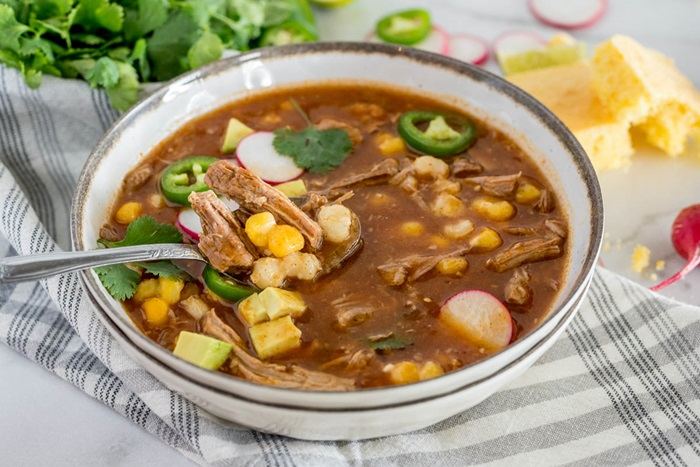Mexican hominy, known as “maíz mote” or simply “elotes,” is a staple ingredient that has played a significant role in Mexican cuisine for centuries. This article delves into the detailed process of preparing and cooking Mexican hominy, exploring its ingredients, techniques, and cultural significance. Whether you’re an experienced chef or a culinary enthusiast, mastering this dish can provide insight into the heart of Mexican-American traditions.
Introduction to Mexican Hominy
Introduction to Mexican Hominy: Mexican hominy refers to dried corn kernels that have been treated with an alkali solution, such as lime water (calcium hydroxide), in a process called nixtamalization. This ancient technique not only enhances the nutritional value of the corn but also gives it a distinct flavor and texture. Nixtamalized corn is used in various dishes, from soups and stews to tamales and pozole. Understanding the preparation and cooking of Mexican hominy allows us to appreciate its versatility and cultural importance.
Ingredients Needed for Preparing Mexican Hominy
Ingredients Needed for Preparing Mexican Hominy: To prepare Mexican hominy at home, gather these ingredients:
- 1 pound dried corn kernels
- 2 tablespoons slaked lime (calcium hydroxide)
- Water for soaking and cooking
- Salt to taste
Each ingredient plays a crucial role in transforming regular corn into flavorful hominy. The dried corn kernels serve as the base, while the slaked lime facilitates the nixtamalization process, enhancing both texture and flavor. Water and salt are essential for cooking and seasoning the hominy.
Soaking and Preparing the Corn Kernels
Soaking and Preparing the Corn Kernels: Begin by sorting through the dried corn kernels to remove any debris or damaged pieces. Ingredients needed:
- 1 pound dried corn kernels
- 2 tablespoons slaked lime
- Water for soaking
Place the corn kernels in a large bowl and cover them with water. Add the slaked lime and stir well to ensure even distribution. Let the mixture soak overnight or for at least 8 hours. During this time, the lime will soften the corn and loosen the outer hulls. After soaking, drain and rinse the corn thoroughly under running water until the water runs clear. This step removes excess lime and loosened hulls, preparing the corn for cooking.
Cooking Techniques for Mexican Hominy
Cooking Techniques for Mexican Hominy: Once the corn is prepared, it’s time to cook it. Ingredients needed:
- Prepared corn kernels from soaking
- Fresh water for cooking
- Salt to taste
Transfer the soaked corn kernels to a large pot and cover with fresh water. Bring the water to a boil, then reduce the heat to a simmer. Cook the hominy for about 1 to 2 hours, stirring occasionally, until the kernels are tender and the outer hulls have completely separated. Add salt during the last 30 minutes of cooking for flavor. Proper cooking ensures the hominy is soft and ready to be used in various dishes.
Using Mexican Hominy in Dishes
Using Mexican Hominy in Dishes: With the hominy now cooked, it’s ready to be incorporated into different recipes. Here are some popular uses:
Pozole: A traditional Mexican soup made with hominy, pork or chicken, chili peppers, and garnishes like lettuce, radish, and lime.
Tamales: Steamed corn dough wrapped in corn husks, often filled with meats, cheeses, or vegetables.
Elote: Grilled corn on the cob served with mayonnaise, sour cream, cheese, and spices.
Soups and Stews: Adding hominy to hearty soups and stews provides a chewy texture and rich flavor.
Each dish showcases the versatility of Mexican hominy, allowing it to shine in both simple and complex preparations. Incorporating hominy into your cooking repertoire opens up a world of flavors and textures.
Cultural Significance
Cultural Significance: Mexican hominy holds deep cultural roots, reflecting the agricultural heritage and culinary traditions of Mexico. It symbolizes sustenance and community, playing a central role in festivals and everyday meals. The process of nixtamalization dates back to ancient Mesoamerican civilizations, where corn was a vital crop. By preparing and enjoying dishes made with hominy, we honor this legacy and celebrate the craftsmanship of Mexican cuisine. Sharing these dishes fosters connections and preserves cultural identity, bringing people together through shared enjoyment of food.
Conclusion
In conclusion, preparing and cooking Mexican hominy is a rewarding journey into the heart of Mexican-American cuisine. From selecting the right ingredients to perfecting the cooking techniques, each step contributes to creating a dish that is visually appealing and deliciously satisfying. By preparing and enjoying hominy-based dishes, we honor the traditions of Mexican-American cuisine and appreciate the craftsmanship that goes into each bite. Whether eaten at a grand fiesta or a casual gathering, these dishes remain timeless favorites that foster connections and preserve cultural identity. Through the preparation and appreciation of Mexican hominy, we celebrate the beauty and diversity of global flavors, ensuring that this delightful culinary tradition continues to thrive in our lives.
Related topics:


